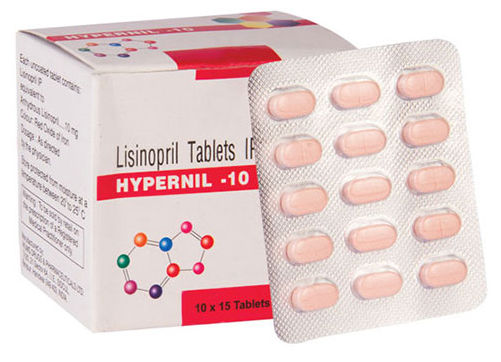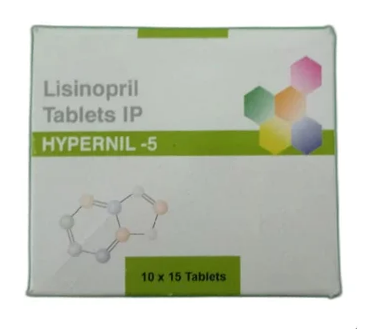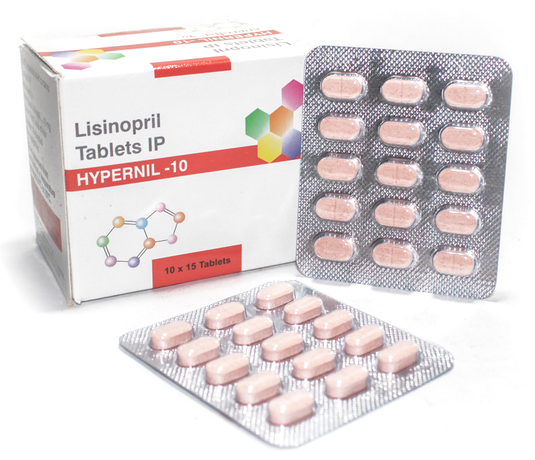Buy Generic Zestril Online
- Brand: Hypernil-2.5 / Hypernil-5 / Hypernil-10
- Composition: Lisinopril
- ATC code: C09AA03 / C09BA03 / C10BX07 / C09BB03
- Pharmacotherapeutic group: ACE inhibitors
- Dosage form: Pills
- Treatment: Hypertension
- Packaging Size: 10 x 15 Tablets
- Manufacturer: Lupin Limited

Using Generic Zestril:
- Arterial hypertension (in monotherapy or in combination with other antihypertensive agents);
- chronic heart failure (as part of combination therapy for the treatment of patients taking cardiac glycosides and/or diuretics);
- early treatment of acute myocardial infarction (in the first 24 hours with stable hemodynamic parameters to maintain these indicators and prevent left ventricular dysfunction and heart failure);
- diabetic nephropathy (reduction of albuminuria in patients with type 1 diabetes mellitus with normal blood pressure and in patients with type 2 diabetes mellitus with arterial hypertension).
How Does Generic Zestril Work?
Generic Zestril is a prolonged—acting angiotensin converting enzyme (ACE) inhibitor, intended for the treatment of hypertension and the prevention of its complications. The peculiarity of the drug is that it is not metabolized in adipose tissue, which makes it possible to use it effectively in overweight patients.
What Are The Contraindications Of Generic Zestril?
- Hypersensitivity to lisinopril, other components of the drug or other ACE inhibitors;
- a history of angioedema (including from the use of other ACE inhibitors); hereditary Quincke’s edema and / or idiopathic angioedema;
- age under 18 years (efficacy and safety have not been established);
- pregnancy and breastfeeding;
- lactose intolerance, lactase deficiency, glucose-galactose malabsorption syndrome (the drug contains lactose);
- simultaneous use with aliskiren and drugs containing aliskiren in patients with diabetes mellitus and/ or moderate or severe renal impairment (glomerular filtration rate (GFR) less than 60 ml/min / 1.73 m2 of body surface area);
- concomitant use with angiotensin II receptor antagonists (ARA II) in patients with diabetic nephropathy;
- simultaneous use with neutral endopeptidase inhibitors (for example, with drugs containing sacubitril) due to the high risk of angioedema.

Dosage Of Generic Zestril
- Try to take the pills at the same time try to take the pills at the same time every day. It doesn’t matter if you take Generic Zestril before or after a meal.
- Continue taking Generic Zestril as long as the doctor tells you, as this is a long-term treatment. It is important to continue taking Generic Zestril every day.
- Take special care when taking the first dose of Generic Zestril or when increasing the dose. It can cause a more severe decrease in blood pressure than subsequent doses.
This may cause dizziness or dizziness. In this case, it is better to lie down. If something bothers you, contact your doctor as soon as possible.
Adults:
The dose depends on your health condition and whether you are taking any other medications. Your doctor will tell you how many pills you need to take each day. If you are not sure about this, consult your doctor.
For high blood pressure:
- The recommended starting dose is 10 mg once a day.
- The usual long-term dose is 20 mg once a day.
In case of heart failure:
- The recommended starting dose is 2.5 mg once a day.
- The long-term dose is from 5 to 35 mg once a day.
After a heart attack:
- The recommended initial dose is 5 mg within 24 hours after the attack.
- The usual long-term dose is 10 mg once a day.
For kidney problems caused by diabetes:
The recommended dose is 10 mg or 20 mg once a day. If you are an elderly person, have kidney problems or are taking diuretics, your doctor may prescribe you a lower dose.
Use in children and adolescents (6 to 16 years old) with high blood pressure:
- Generic Zestril is not recommended for children under 6 years of age, as well as children with severe kidney disease.
- The doctor will determine the correct dose for your child. The dose depends on the child’s body weight.
For children with a body weight from 20 kg to 50 kg:
The recommended starting dose is 2.5 mg once a day.
For children with a body weight of more than 50 kg:
The recommended starting dose is 5 mg once a day. If you are taking more Generic Zestril than prescribed by your doctor, contact your doctor or hospital. In this case, the following effects are possible:
Dizziness, rapid heartbeat
- If you forgot to take a dose, take it as soon as you remember. However, if the time for the next dose is almost right, do not take a double dose to make up for the missed one.
- Do not stop taking the pills, even if you feel well, unless your doctor has advised you to do so.
Side Effects of Generic Zestril
The usual ones:
Headache, Dizziness or dizziness, Diarrhea, Dry cough that does not go away, Nausea (vomiting), Kidney problems (according to the results of a blood test).
Often:
Mood changes, Discoloration of fingers or toes, Changes in taste sensations, Drowsiness, Dizziness, Difficulty sleeping, Stroke, Palpitations, Runny nose, Feeling of nausea, Abdominal pain or indigestion, Skin rash or itching, Impotence, Feeling tired or weak, Severe decrease in blood pressure, Changes in blood tests which show how well the liver and kidneys are working, a heart attack, and hallucinations seen and/or heard.
Rare:
Feeling confused, lumpy rash (urticaria), dry mouth, hair loss, psoriasis (skin disease), change in the smell of things, breast enlargement in men, low sodium levels in the blood (symptoms may include fatigue, headache, nausea, vomiting), Sudden kidney failure, Your doctor may from time to time take blood samples to check if Zestril has any effect on your blood. Signs may include feeling tired, pale skin, sore throat, high fever (fever), joint and muscle pain, joint and muscle pain, swelling of joints or glands, sensitivity to sunlight.
Very rarely:
Sinusitis, shortness of breath, low blood sugar, pneumonia, yellowing of the skin or whites of the eyes (jaundice), Inflammation of the liver, Inflammation of the pancreas, Severe skin diseases, Sweating, Less water (urine) compared to the norm or complete lack of water, Liver failure, Lumps, Intestinal inflammation.
Contents
- 1 Buy Generic Zestril Online
- 2 Dosage Of Generic Zestril
- 2.1 Adults:
- 2.2 For high blood pressure:
- 2.3 In case of heart failure:
- 2.4 After a heart attack:
- 2.5 For kidney problems caused by diabetes:
- 2.6 Use in children and adolescents (6 to 16 years old) with high blood pressure:
- 2.7 For children with a body weight from 20 kg to 50 kg:
- 2.8 For children with a body weight of more than 50 kg:
- 2.9 Dizziness, rapid heartbeat
- 3 Side Effects of Generic Zestril



